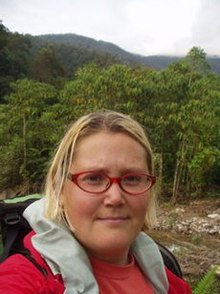Amy Townsend-Small
Amy Townsend-Small is the director of the Environmental Studies Program as well as an associate professor in the Department of Geology and Geography at the University of Cincinnati.[1]
Amy Townsend-Small | |
|---|---|
 Townsend-Small in 2005 | |
| Born | 1976[citation needed] Seattle, Washington, US |
| Nationality | United States |
| Alma mater | Skidmore College, University of Texas at Austin |
| Awards | OEC's Science and Community Award |
| Website | University of Cincinnati Faculty Website |
Early life and education[]
Townsend-Small was born in Seattle, Washington. She grew up in Holliston, Massachusetts, and graduated from Holliston High School.[citation needed] While attending Skidmore College in 1997, Townsend-Small spent a semester at the Marine Biological Laboratory in Woods Hole, Massachusetts as part of the Semester in Environmental Science program.[citation needed][2] During this semester she produced a research project investigating the use of nitrogen stable isotopes as tracers of wastewater inputs to groundwater, and has continued to work with isotopes and marine environments since.[citation needed]
In 1998, Townsend-Small graduated magna cum laude from Skidmore College, receiving a bachelor's degree in both English literature and environmental biology.[1] She received a PhD in marine science from the University of Texas at Austin in 2006, where she had done dissertation research investigating carbon cycling and its relationship with climate in the Amazon River headwaters of Peru.[3]
Career and research[]
Townsend-Small's dissertation research focused on examining the particulate organic matter (POM) carried downstream by rivers from the Andes Mountains in Peru to the Amazon River, paying special attention to the elemental and isotopic compositions of carbon and nitrogen in the POM.[3] After receiving her PhD, Townsend-Small worked at the University of Texas at Austin as a Postdoctoral Researcher studying the connection between changing climate and the export of carbon, nitrogen, and dissolved nutrients in rivers of the Alaskan Arctic.[4] In 2007, Townsend-Small began working as a Postdoctoral Scholar and Project Scientist in the Department of Earth System Science at the University of California Irvine, where she conducted research regarding urban greenhouse gas and water budgets in Los Angeles, California.[5] Since 2010, Townsend-Small has been at the University of Cincinnati, where she is now an associate professor in the Department of Geology and Geography as well as the director of the Environmental Studies Program.[1] Her current research at UCI investigates anthropogenic sources of methane and climate change feedbacks to the global carbon cycle.[6]
Awards and honors[]
In 2010, Townsend-Small led a research project known as UC GRO (Groundwater Research of Ohio), run by the University of Cincinnati.[7] The study involved testing samples of groundwater from eastern Ohio for dissolved methane concentrations in order to determine the relationship between contaminated groundwater and the process of hydraulic fracturing (fracking) for natural gas.[8] In praise of the project's innovative and unique groundwater analysis techniques, the Ohio Environmental Council (OEC) awarded Townsend-Small the Science and Community Award in 2014.[9]
References[]
- ^ Jump up to: a b c "Faculty, Staff and Students". University of Cincinnati. Retrieved 2018-09-17.
- ^ "SES Alumni List by College". www.mbl.edu. 2014-10-06. Retrieved 2018-09-17.
- ^ Jump up to: a b Townsend-Small, Amy (2006). "Carbon and nitrogen cycling in the Peruvian Andean Amazon". Cite journal requires
|journal=(help) - ^ Townsend-Small, Amy; McClelland, James W.; Max Holmes, R.; Peterson, Bruce J. (2010-05-09). "Seasonal and hydrologic drivers of dissolved organic matter and nutrients in the upper Kuparuk River, Alaskan Arctic". Biogeochemistry. 103 (1–3): 109–124. doi:10.1007/s10533-010-9451-4. ISSN 0168-2563.
- ^ Townsend-Small, Amy; Pataki, Diane E.; Czimczik, Claudia I.; Tyler, Stanley C. (2011). "Nitrous oxide emissions and isotopic composition in urban and agricultural systems in southern California". Journal of Geophysical Research: Biogeosciences. 116 (1): G01013. Bibcode:2011JGRG..116.1013T. doi:10.1029/2010JG001494. ISSN 0148-0227.
- ^ Alvarez, Ramon A.; Zavala-Araiza, Daniel; Lyon, David R.; Allen, David T.; Barkley, Zachary R.; Brandt, Adam R.; Davis, Kenneth J.; Herndon, Scott C.; Townsend-Small, Amy (2018-06-21). "Improved characterization of methane emissions from the U.S. oil and gas supply chain". Science Magazine. 361 (6398): 186–188. Bibcode:2018Sci...361..186A. doi:10.1126/science.aar7204. PMC 6223263. PMID 29930092.
- ^ Baker, Jon. "Study shows natural gas drilling not contaminating water wells in Carroll County". Times Reporter. Retrieved 2018-09-17.
- ^ Claire Botner, E.; Townsend-Small, Amy; Nash, David B.; Xu, Xiaomei; Schimmelmann, Arndt; Miller, Joshua H. (2018-05-03). "Monitoring concentration and isotopic composition of methane in groundwater in the Utica Shale hydraulic fracturing region of Ohio". Environmental Monitoring and Assessment. 190 (6): 322. doi:10.1007/s10661-018-6696-1. ISSN 0167-6369. PMID 29721622. S2CID 22886887.
- ^ "UC Fracking Research Receives First-Ever Science and Community Award from Ohio Environmental Council". UC News. 2014-11-16. Retrieved 2018-09-17.
- Living people
- Scientists from Seattle
- People from Holliston, Massachusetts
- University of Cincinnati faculty
- Skidmore College alumni
- University of Texas at Austin alumni
- Environmental scientists
- American women scientists
- 20th-century American scientists
- 21st-century American scientists
- 1976 births
- 20th-century American women
- American women academics
- 21st-century American women